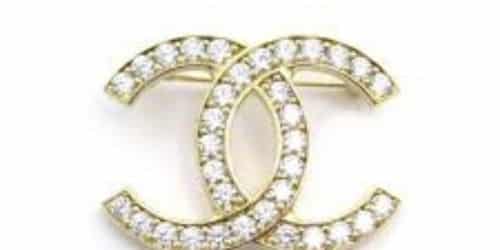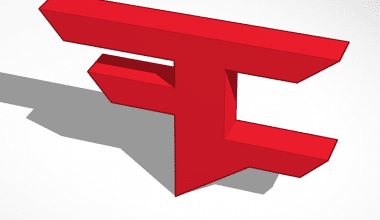Gabrielle Chanel, better known as Coco Chanel, designed the Chanel emblem in 1925. The emblem has dominated the designs and packaging of all Chanel items, and it is also applicable to bags, shoes, and jewelry, and it is an important aspect of the brand’s image. This article talks about the history of the Coco Chanel logo, its font, necklace, and earrings.
What Does the Chanel Logo Symbolize?
The famous Chanel symbol was in existence at the start of the fashion business as a reflection of Gabriele Chanel’s primary principles: comfort, geometry, and clean lines.
The logo consists of two identical and different sides of the letters “C”, which stands for “Coco Chanel” and was in a narrow circular frame. All elements are perfectly good and have clean and crisp curves, conveying a sense of harmony and perfection in shapes, space, and style.
Since 1925, the emblem has appeared on every bottle of Chanel perfume, and a year later, it has become an indispensable feature of every fashion house’s collection, appearing on prints, purses, and jewelry, with or without its circular shape.
Coco Chanel Logo
Gabrielle Bonheur Chanel was born on August 19, 1883, in Saumur, France. She became known as “Coco Chanel” later in life. In contrast to her adult life, she did not grow up in the affluence and glitter for which she became famous. However, after the death of her mother, she was brought up in an orphanage by nuns. The nuns taught her how to sew as a child, which proved to be a useful lesson for her. Chanel had moved to Paris by the age of twenty, had climbed the social ladder, and had made connections with some extremely wealthy individuals. In 1910, she built her first store with the support of her friend Arthur Chapel and began selling hats. As her business expanded, she opened two more stores in France and began selling her own clothing designs.
Her first taste of success came on a chilly morning in France, when she fashioned a dress out of an old jersey. When passers-by questioned where she acquired the outfit, Chanel offered to make one for them. In a quote, she is quoted as saying, “My fortune is built on the old jersey I wore because it was cold in Deauville.” Her business took off, and she went on to design the Chanel emblem, the iconic Chanel number five, and the “little black dress.” By the mid-1920s, Chanel had established a massive fashion house, one of which is still going strong today.
Additional Information
Chanel’s designs were frequently elegant, rich, and inspired by menswear. Chanel was among the first designers to create less constricting clothing for women. As many of the upper classes began to experience the effects of WWI, Chanel’s designs became increasingly popular because of the boxy lines and shorter skirts, which allowed them to accomplish the activities that the war required.
Her first taste of success came when she made a garment out of an old jersey on a chilly morning in France. Bystanders had amazing feelings about the design and had to ask where she obtained the dress. She said that it was her own design and offered to construct one for them. Chanel considers this humble recollection to be the germ of her ultimate great fortune.
Her most famous design, which is still in use today, was gaining traction by the 1920s. Her perfume, Chanel No. 5, was an instant success. More than that, it is stated that the perfume alone encapsulated the character of a modern and independent lady. Her outfit designs reflected this viewpoint.
Chanel also popularized the “little black dress,” which has since become a staple in most women’s collections. Chanel had the feeling that every lady should have a little black dress in her closet—an outfit that can be useful for any occasion.
In 1954, she introduced a new version of the Chanel suit—this ensemble is the most influential of her designs and is still well recognized and remembered today. A Chanel suit is characterized by a boxy, collarless blazer and a fitted skirt. Chanel was one of the first designers to create less confining clothing for women.
Meaning of the Coco Chanel Logo
Because it is one of the most memorable trademarks in the fashion world, the Coco Chanel emblem is recognizable as a crucial component in the brand’s immense success. Chanel, as a designer, appealed to elegant and refined women with simple but striking designs.
Her fitted outfits replaced the customary over-designed and constricting clothing of nineteenth-century women’s fashion. The logo, rooted in class and simplicity, exudes an atmosphere of legendary history and tradition.
The Coco Chanel logo consists of two black interlocking Cs that represent the designer’s name. Chanel designed the emblem, which would be associated with the firm even after her untimely death in 1971. Though it is easy to see the logo as a name-brand graphic, the background behind it emphasizes the significance of roots.
The logo was inspired by Chanel’s upbringing in an orphanage. According to one popular legend, the interlocking C’s of the Coco Chanel emblem was inspired by stained glass windows in an Aubazine chapel that featured interlaced curves and also housed an orphanage where Chanel spent the latter half of her infancy.
Additional Information
The black color of the logo title indicates the sophistication and elegance that Chanel represents and lives by. Furthermore, the logo’s simplicity quietly adds elegance, reflecting Chanel’s idea of “less is more.”
Similarly, Chanel’s interwoven double Cs stand out as the brand’s name appears in bold uppercase letters beneath in much smaller print.
The Cs on her items is in gold, offering a splash of color that draws attention while staying elegant and refined. The double Cs are precisely symmetrical, which is visually appealing. The logo is also scalable, allowing it to be visible on a variety of items independent of kind or size. The Coco Chanel emblem has remained unchanged since its creation in 1925, and it is now a timeless design.
Exciting Facts About Coco Chanel and Its Logo
- The trademark interlocking Cs of Chanel products were not always part of the initial design. After Coco Chanel’s death, Karl Lagerfeld integrated it as a memorial to her.
- Her lovers inspired the charms attached to several Chanel purses. The turtle charm was significant since one of her lovers (a fisherman) told her that turtles brought good luck because they signified that fish were nearby.
- The chain-link straps on several Chanel purses were inspired by the nuns’ rosaries at the orphanage where she grew up.
- Chanel created her tweed jacket with two pockets on each side so she could keep her cigarettes in the left pocket and her sewing gear in the right.
- Coco Chanel was a deeply religious woman. Despite being unlucky for many, her lucky number was 13.
- Wearing black during this time period was usually for tragic events because it was visible as a mourning color. Chanel, on the other hand, made wearing black fashionable for every occasion. She chose black because it was her favorite color and because she believe that it is ” vital.”
- The Chanel brand closed in 1939 owing to World War II, but Coco Chanel revived the fashion firm in 1954, at the age of 71. When a friend and actress Marlene Dietrich questioned her decision, she stated that she was “dying of boredom.”
- Coco Chanel did not marry. Hugh Grosvenor, Duke of Westminster, was her lover for ten years. He eventually proposed to the designer marriage. She later rejected it, adding, “There are many Duchesses, but only one Coco Chanel.”
- The camellia flower is one of Chanel’s most recognizable symbols. It was her favorite flower and she frequently had to add it to her creations, including as a stand-alone brooch. Camellia blossoms are still blooming at her tomb.
Chanel Logo Necklace
The Chanel Fine Jewelry Creation Studio draws inspiration from the timeless BIJOUX DE DIAMANTS pieces to create a fresh story 90 years after the presentation of the first high jewelry line. The Collection 1932 is a journey beyond time and space, seeing the movement of the planets and the dynamics of the stars. Patrice Leguéreau, Director of the Chanel Fine Jewelry Creation Studio, keeps the cosmic concept, the purity of the lines, and the freedom of the body from the original collection. The diamonds’ flawless roundness gives the symbols a sense of eternity, and the light rays make them bright and that makes them glitter.
Guarantee
Each Chanel Fine Jewelry piece is subject to the existing legal warranties. These warranties do not cover the following items:
- Damage caused by an accident or inappropriate or abusive use of a jewelry piece.
- Damage caused by repairs or dismantling not performed by a Chanel shop.
- The effects of normal wear and aging on a piece of jewelry.
Chanel Fine Jewelry can provide repairs beyond these warranties for the life of each fine jewelry piece. Call 800.550.5355 for additional information. The following list of Chanel jewelry necklaces is below:
- Chanel Double Chain Gold Loupe.
- Chanel Classic Edition Pearl Necklace with Three CC Logo Pears.
- Chanel 22S Gold Chain Link White Cuban CC Logo Adjustable Short Choker Necklace.
- Chanel Auth Coco Vintage Rare Silver CC Logo Black Pearl Long F/S Necklace Chain.
- Used Vintage Chanel CC Logo Gold Round Chain Necklace, etc.
Authenticity
Chanel Fine Jewelry has created your piece with painstaking attention. Chanel guarantees that all Chanel Fine Jewelry is of gold (750) or platinum (950).
Only purchasing a Fine Jewelry piece from a Chanel boutique ensures its authenticity. Similarly, only genuine Chanel Fine Jewelry pieces are repairable.
Chanel Logo Earrings
Chanel logo earrings draw attention to the face in an attractive way. The jewelry designs are inspired by House emblems that define a widely recognized allure.
Earrings from the well-known Chanel costume collection are usually often constructed of base metals. Rhodium, stainless steel, and rhodium over steel are examples of this. This costume line never uses precious metals like gold, platinum, or sterling silver.
Chanel continues to manufacture in France for ready-to-wear and haute couture lines, but they have also spread their jewelry manufacturing to other common manufacturing countries such as Italy and Spain. The High Jewelry pieces are created entirely in their Parisian atelier near Place Vendome.
Boutique Lines Make Use of Precious Metals and Diamonds
Chanel has employed precious metals and gems in their boutique lines such as the high-end “Comète,” “Camélia,” “Baroque,” “Ultra,” “Bridal,” and “1932,” which boast superb handcrafted earrings, and obtaining vintage pairs will be an essential investment. Other lines from this category to keep an eye out for is “Designer,” “Mademoiselle,” and “Coco.”
Erasable Chanel Signature Stamps
Chanel has used a variety of signature stamps over the years. To differentiate a real piece from a fake, examine both the type and positioning of the signature marks visible on the piece. Examine the font, depth, and placement of the insignias in particular.
Costume jewelry created before 1939 was not identified, making determining its authenticity impossible unless you are an expert. Because the stamps first appeared between the 1950s and the early 1960s, authentic Chanel jewelry from that era will have a basic Chanel emblem in all capital letters, occasionally complemented by a line of three stars underneath. Because the stamping technique was new back then, the hallmarks are frequently irregular.
In the 1970s, Chanel jewelry began to feature the brand name and copyright mark, which changed a decade later. In the 1980s, Chanel jewelry had a trademark logo, along with an emblem, a copyright symbol, and the year it was made. From 1986 to 1990, jewelry had two numerals on either side of the Chanel logo on the trademark placard. In the early 1990s, the year of manufacture was recognizable as a two-digit number and season code.
Since the Early 2000S, Laser Etching Has Been Used on Jewelry
Chanel has used laser etching in the jewelry creation process since the early 2000s. Since then, genuine Chanel costume earrings should have been laser-engraved. The sharpness of the logo and lettering indicates laser etching.
Signs of Real Chanel Logo Quality for Earrings, and Other Jewelry
Other than stamping and laser etching, there are other tell-tale characteristics of fake Chanel jewelry. Chanel earrings, for example, should have a double-forged back, and the stones should not be prone to slipping out. Furthermore, the metal should not bend and should feel firm to the touch.
The early baroque and Byzantine influences on Chanel jewelry are a result of Coco Chanel’s partnership with Robert Goossens. Many antique Chanel pieces from that era (the 1950s and 1960s) have Gripoix glass elements, which are jewel-toned stones created from molten glass and utilized to create the trademark Chanel imitation pearl sheen.
Furthermore, costume earrings made between the 1970s and 1990s should feel hefty because the vast majority were crafted from thick base metal.
Understand Your Jeweler
The easiest way to ensure that the antique Chanel logo earrings or necklace you are purchasing are authentic is to get them from a respected jewelry store that specializes in vintage jewelry. Since 1980, Leo Hamel Fine Jewelry & Engagement Ring Store has been providing real vintage jewelry.
Though it is not always possible, it is preferable to buy used Chanel jewelry in person. The majority of internet resellers will supply a close-up photo of the signature, but there are other significant authenticating aspects that are not as evident. Request to hold or try on the item when shopping. A ring, bracelet, necklace, anklet, or pair of earrings should feel substantial and hefty; it should never seem light and hollow. Examine it from every aspect. There should also be no visible traces of workmanship, such as soldering lines.
Chanel Logo History
Chanel is the epitome of luxury. The world’s most famous fashion house had its existence in 1910 in Paris by a legendary woman who is recognized as Gabrielle “Coco” Chanel. Today, the company, famous for its little black dresses, has a women’s fashion line, cosmetics, sports equipment, and, of course, perfume, which is sold all over the world. The company’s annual sales exceed $10 billion USD.
The classic Chanel suit was in existence in 1925 and was an instant success. The style, which included a collarless jacket and a form-fitting skirt, was revolutionary at the time and introduced ladies to a new type of fashion. The original design is still useful in several of today’s channel designs.
Another creation that altered the fashion world as we know it now was the little black dress. Prior to the introduction of channels, black was exclusively useful for funerals and was useful together with the dawn. Chanellv’s first jewelry line was likewise an instant success, particularly the imitation pearls, which Harper’s Bazaar termed “one of the most groundbreaking creations of our time.” Both of these original designs are still useful in the fashion house nearly a century later.
Additional Information About the Chanel Logo History
However, in the Chanel logo history, the Chanel logo contains two black interlockings “c”s that stands for the founder’s name. It was also designed by Coco Chanel herself, forever tying her to the company. The design was supposedly inspired by Chanel’s childhood orphanage, as the curve of the windows resembles the Chanel logo. The logo’s black color signifies the refinement and sophistication that Chanel embodies. The logo’s minimalism adds elegance while also adhering to Chanel’s idea of “less is more.” It has never changed since it was designed in 1925 and has kept the classic design that you see today.
Coco Chanel created the Chanel emblem in 1925. It is made up of two large interwoven “C”s that mirror each other. The letters’ basic, bold shapes suggest the commanding elegance of simplicity, which is based on Coco’s belief of “less is more.” The emblem is black, a distinctive hue with special significance for the house.
Black was primarily used only for sorrow and religious clothing throughout her time. The color was deemed unsuitable for social or fashion goals. Then Madame introduced the ‘Little Black Dress,’ which revolutionized everything. She single-handedly redefined black as the ultimate fashion color, forever linking it with the brand.
From 1909 Until the Present
Also, in the Chanel logo history, the Chanel logotype is a celebration of the brand’s traditions and heritage, and it has remained unchanged since its debut in 1910. The legendary designer’s simple yet prominent black-and-white wordmark was placed on all fashion goods and stood for elegance, comfort, and sophistication.
The Chanel logo is made up of two parts: a logotype and an emblem, which can be used together or independently, but combined they form the most identifiable fashion insignia of all time.
What Does the Chanel Logo Represent?
The double CC is widely used to represent ‘Coco Chanel.’ Chanel was born Gabrielle Bonheur Chanel, but her friends and colleagues referred to her as Coco. There are a handful of amusing anecdotes about how she got the nickname.
According to one tale, she was given the nickname “Coco” during a brief run as a cabaret singer. However, according to mythology, she was nicknamed Coco because of her songs “Ko Ko Ri Ko” and “Qui qu’a vu Coco dans l’Trocadero?”
According to another narrative, Chanel stated that Coco was short for ‘cocotte,’ the French word for ‘kept lady,’ because she had mistress status with renowned society men, some of whom financially supported her business and career because they believed in her abilities.
Whether or not these stories were true, they simply serve to highlight the spirit of the woman behind the brand.
Chanel Logo Font
The logo font is basic and minimalist, which reflects the designs developed by Chanel. The font can be found on practically every garment designed by the fashion business.
Couture is the name of the font that was created exclusively for the brand. The Chanel typeface is established in all capital letters with bold and crisp lines, representing the brand’s simplicity with a hint of extravagance. It is displayed in a classic sans-serif typeface and is strikingly similar to fonts such as RoundCut Bold, Double Porter 3, and ITC Blair’s Pro Bold—but with changes.
Chanel’s handwriting was used to develop the Couture font, which she eventually registered. It’s a simple font that’s versatile, readable, and scalable—all qualities of a good logo.
Additional Information
The font selected is simple and minimalist, and it reflects Chanel’s designs. This font may be found on practically every piece of packaging designed by the fashion house, particularly the classic channel number five perfume, which is sold every fifty seconds on average. The brand’s huge success is attributed to the logo, which is one of the most recognizable emblems in the fashion industry. The impact on the brand’s reputation and success demonstrates how influential the design is.
The primary Chanel badge’s signature logotype is set in uppercase in a bold modern sans-serif typeface with stable characters written in crisp lines, straight cuts, and distinctive curves. Rexton Bold, Brimstone Display, or Tapas Sans are probably the closest typefaces to the one used in the Chanel emblem.
In terms of the Chanel visual identity’s color palette, the iconic fashion house follows the industry’s most frequent trend, employing a simple and timeless combination of black and white, which appears exceptionally powerful and exquisite on these stable modern shapes of the elements.
Why Does Chanel Have 2 C’s?
The Chanel logo’s romantic tail suggests that the C’s actually sell for Chanel and Capel, reflecting the love Coco and “Boy” (Chapel) had throughout the years. Others claim that the C’s were designed to depict two horseshoes in order to draw attention to the fashion house.
Chanel created the interlocking Cs in 1925 as a tribute to a monastery in Aubazine, France, where she spent most of her upbringing. The geometric patterns of stained glass windows in the abbey chapel were supposed to have inspired the French designer.
Who Created the Double C Logo?
The double C logo was conceived by Coco Chanel herself for the launch of the Chanel N°5 fragrance in 1921. Although her given name was Gabrielle, she selected the double C as a nod to her childhood nickname, “Coco.” The double C was also a throwback to her childhood.
Is the Chanel Logo a Monogram?
Coco Chanel’s C-shaped monogram is one of the most successful success stories in the history of fashion branding. The emblem has been a world-renowned symbol for the House of Chanel since its creation in the mid-1920s. The Logomania era began in the 1980s when fashion labels emblazoned their logos throughout collections and accessories.
Louis Vuitton, Chanel, and Gucci are some of the most renowned monogram trademark designs – they’ve been around for decades and have global recognition.
What Does the Double C Logo Mean?
The double CC represents ‘Coco Chanel.’ ‘ Chanel was born Gabrielle Bonheur Chanel, but her friends and colleagues refer to her as Coco.
What Is the Double C Logo?
Chanel is well-known for its logo, which consists of two “C’s” back-to-back.
When was the Chanel Logo Designed?
The now-iconic Chanel logo was first conceived in the year 1999. Since then, it has not been updated in any way. The CC monogram, which features an uppercase sans-serif wordmark in bold distinctive lines, may be accompanied by additional graphical elements or framing for certain special collections; however, the essential component of the badge will never change.
Why Chanel Logo is “CC”?
The initials of Gabrielle Coco Chanel, the company’s namesake, and founder are represented by the initials “CC” in the monogram that is featured on the logo of the French fashion house. Gabrielle was given the nickname Coco while she was performing in cabaret. And this is due to the fact that she was of short stature and had the figure of a bird.
Has the Chanel Logo Ever Changed?
Gabrielle Chanel, the namesake of the illustrious fashion house, designed the initial version. This version now known as the Chanel logo in 1909 has not been altered in any way since that time. The CC monogram has evolved into a symbol of sophistication and opulence in modern times, and it is now commonly associated with high fashion and exclusive design.
Why Is the Chanel Symbol So Effective?
Even though the Chanel logo is straightforward, it has a fantastic impact. It is simple to understand why the Company has resisted the need to rebrand over the years.
Even though the Chanel emblem has been around for more than a century, it is still recognizable and distinctive today.
The Chanel emblem honors the creator’s distinctive aesthetic and creative vision. Even if the proprietors of the company have changed throughout the years, the Chanel emblem has never strayed from the fundamentals of the fashion label.
The symbol is straightforward and effective; it communicates a sense of usefulness, originality, appeal, and quality.
The Chanel logo, in contrast to other company logos over time, has been able to keep its impact and air of modernity. Although the company periodically mixes in the Chanel name and the circle surrounding the interlocking Cs, the image has never needed to be made simpler or updated.
In the realm of branding, this is extremely uncommon.
Conclusion
Chanel is famous for producing high-quality items such as jewelry. Her products are still of high quality.
Related Articles
- MOST EXPENSIVE NECKLACE: Top 10 Most Expensive Necklaces 2023
- Luxury Bag Brands: Top 2023 Luxury Handbag Brands List (Updated)
- Handbag Brands: the Best 15 Brands in 2023(Updated!)
- BAG BRANDS: 2023 Top 25+ Luxurious and Designers Bag Brands
- Expensive Purse Brands: List Of Most Expensive Purse Brands






